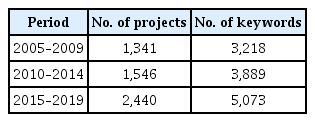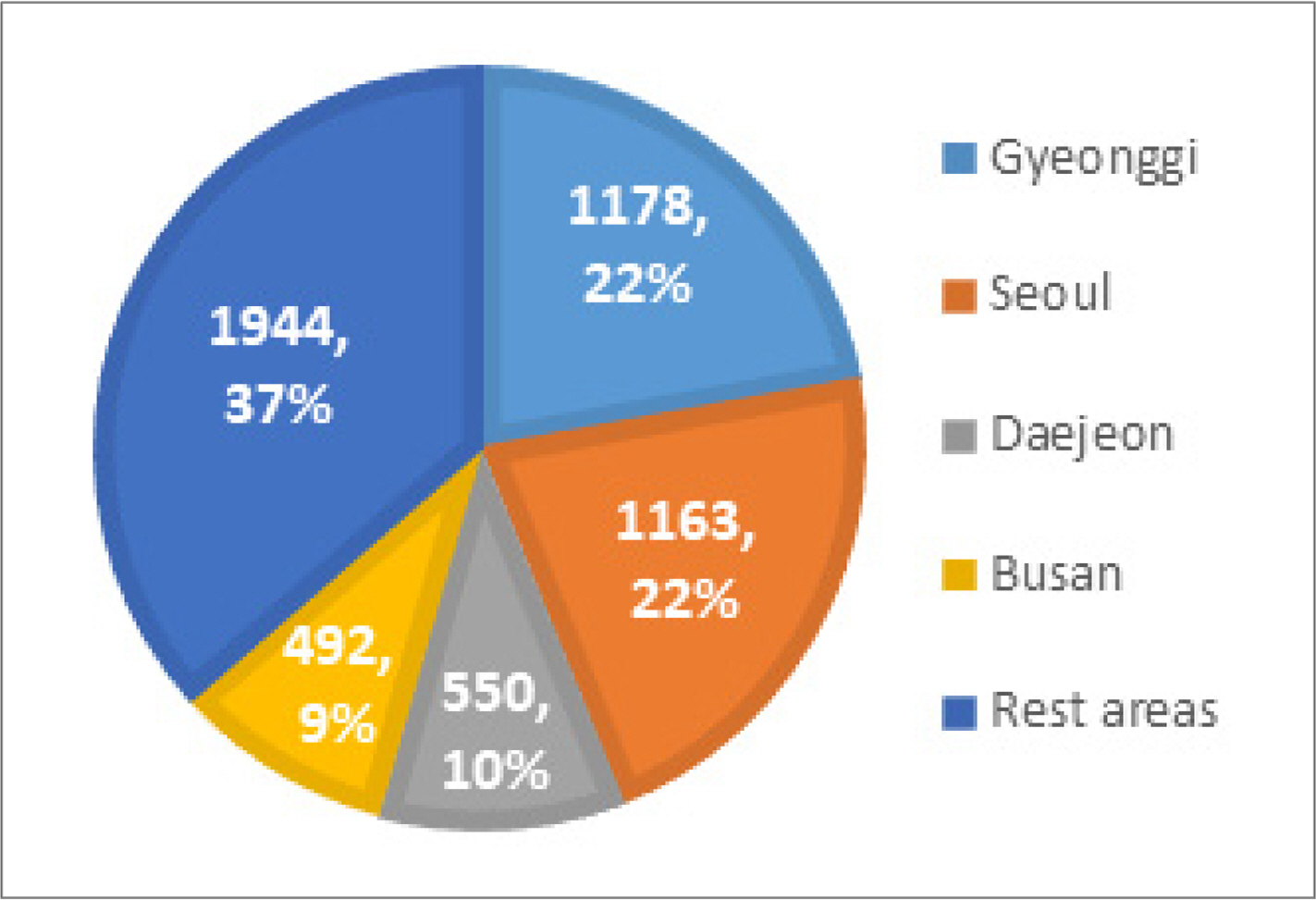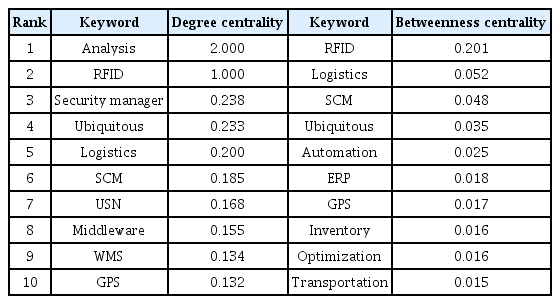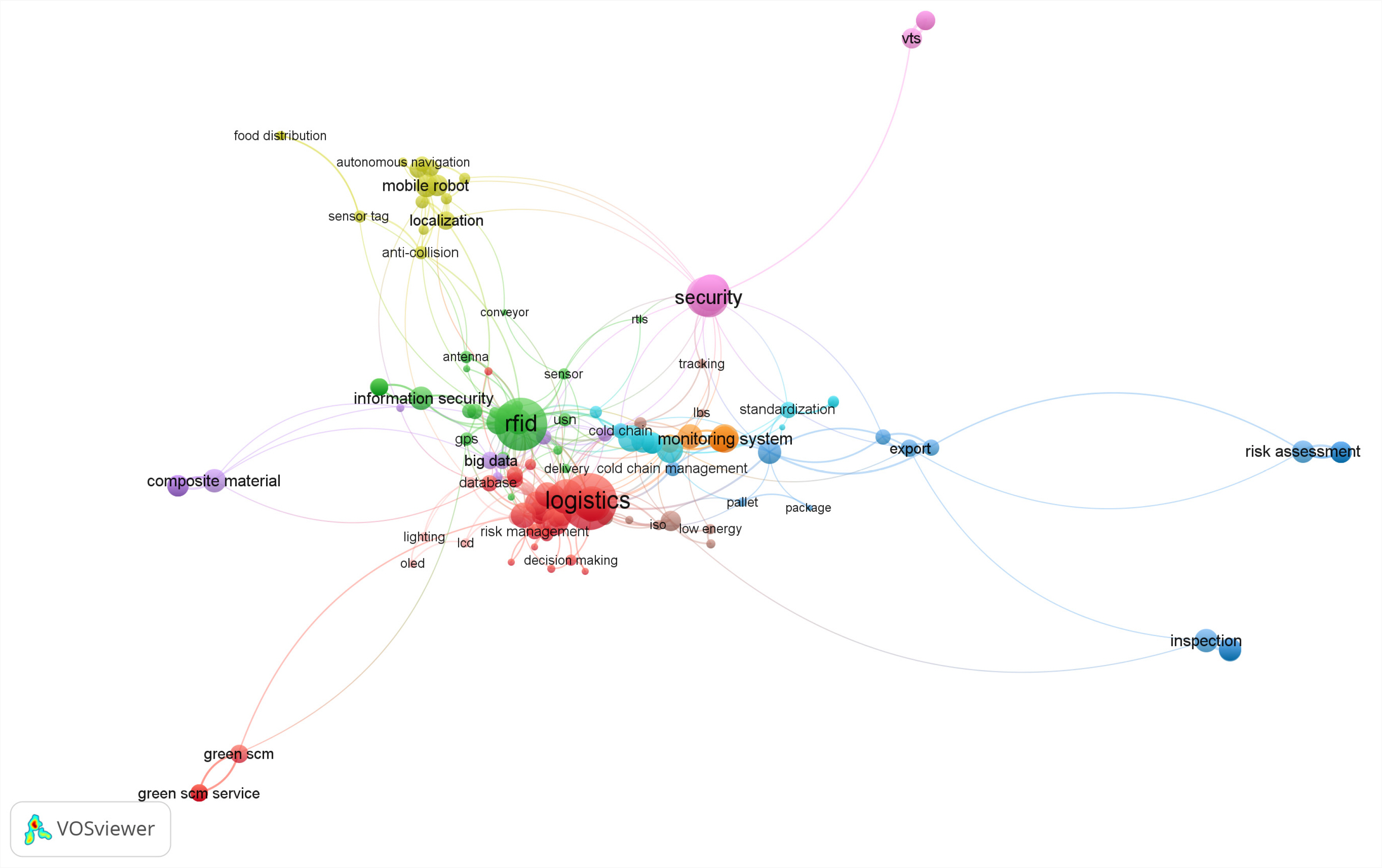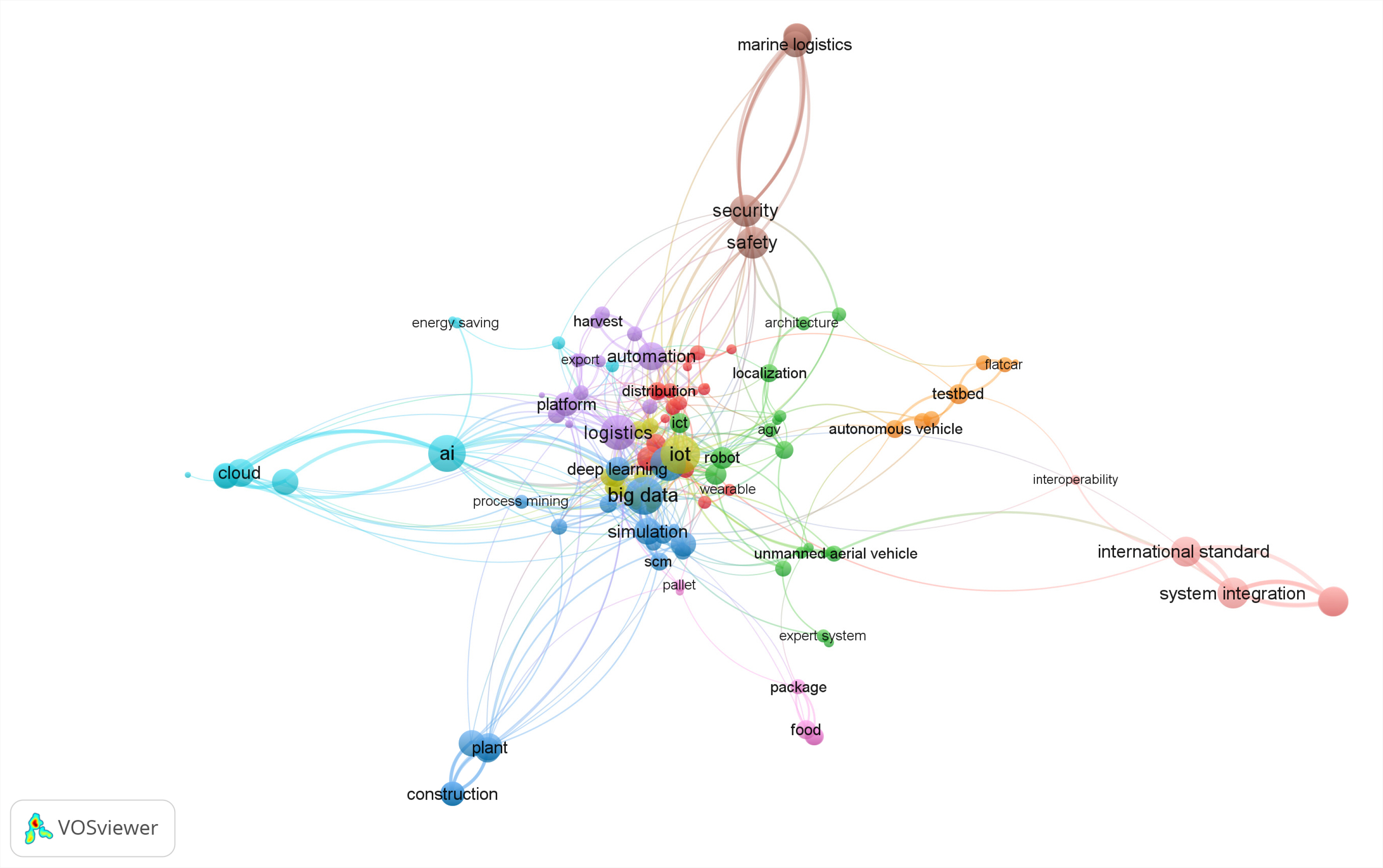Trend Analysis on Korea’s National R&D in Logistics
Article information
Abstract
This study examined how national research and development (R&D) in the domain of logistics has changed recently in the Republic of Korea. We conducted basic statistical analysis and social network analysis on 5,327 logistics-related R&D projects undertaken during 2005–2019. Data for performing these analyses were collected from the R&D database of the National Science and Technology Information Service (NTIS). By constructing a co-occurrence matrix with keywords, we conducted degree and betweenness centrality analysis and visualized the network matrix to display a cluster map. This study presents our observations related to the following findings: (1) the chronical trends of logistics R&D, (2) focused fields of logistics R&D, (3) the relations among keywords, and (4) the characteristics of logistics R&D. Finally, we suggest policy implications to boost and diversify logistics R&D.
1. Introduction
Recently, the scale and importance of the logistics industry has been increasing as e-commerce has become active worldwide and with the proliferation of cross-border logistics. In particular, Industry 4.0 is modifying all industries. Moreover, the logistics paradigm is rapidly changing to Logistics 4.0, in which fourth industrial revolution technologies such as IoT (Internet of things), AI (Artificial tntelligence), big data, and cloud computing are integrated into logistics systems, thus leading to hyper-intelligence and hyper- connection. Additionally, unmanned logistics has been realized using robots and drones, and currently, no boundary exists between distribution and logistics businesses (BISTEP, 2019; Lee, 2018; Wang, 2016). Amid these changes, domestic logistics-related research has been conducted using several approaches, and techniques based on logistics technologies such as block chain and radio frequency identification (RFID) have been developed and applied most extensively (Seon and Kim, 2019; Lee et al., 2013; Lee, 2011; Sheen et al., 2010). In relation to the logistics industry, several studies have focused on efficiency analysis and economic analysis (Kim and Lee, 2018; Lee and Lee, 2016; Park and Kim, 2014). Numerous studies on the advancement of the logistics industry or logistics policies have also been conducted. However, research on investments in logistics research and development (R&D) and the possible directions for logistics R&D at the national level is insufficient. Therefore, the purpose of this study is to examine the changes in national R&D trends related to logistics in the Republic of Korea. Accordingly, we conducted keyword network analysis using national R&D information provided by the National Science and Technology Information Service (NTIS). It was found that government expenditure in logistics R&D, which had been inactive for nearly 10 years since 2005, has rapidly increased since 2015. Moreover, technologies related to Logistics 4.0 are also being researched actively.
2. Research Design
2.1 Analysis Target and Data Collection
In this study, national R&D projects related to logistics were analyzed, and raw data for a total of 15 years, from 2005 to 2019, were obtained from the NTIS. Logistics-related keywords such as “distribution” and “logistics” were used. To identify relevant projects, unrelated projects were discarded from the original raw data based on the title, content, and keywords. The number of relevant projects extracted for each of three five-year periods considered in this study are presented in Table 1.
2.2 Analysis Method
To explore the changes in national R&D trends in the logistics field, first, a basic statistical analysis was performed to extract the fundamental information of R&D projects. Thereafter, network analysis methods were used with English keywords for R&D projects. Synonyms related to abbreviations or resulting from typing errors were integrated into one representative word, and all keywords were converted to lowercase letters to improve the accuracy of the network analysis results. Furthermore, using the co-occurrence analysis method, network and cluster analyses were performed on the keywords extracted for each period. Specifically, in cluster analysis, only the keywords recorded at least 7 times were selected to highlight issue keywords and to use high frequency keywords (Fig. 1). Furthermore, centrality, which is an important parameter in network analysis, was measured based on frequency and distance, which represent the linkage between nodes. In this study, the analysis was focused on degree centrality and betweenness centrality. In particular, a high degree centrality for a keyword indicates that many other keywords are linked to it, which indicates that research is being actively conducted in a specific field related to that keyword. Since betweenness centrality represents the shortest path between two unconnected keywords, a high betweenness centrality implies that the keyword is acting as a bridge between different research fields (Jeong et al., 2018; Lee, 2012; Borgatti et al., 2009). We used Knowledge MatrixPlus 0.80, developed by Korea Institute of Science and Technology Information, to generate the keyword matrix, Gephi 0.80 for centrality measurement through network analysis, and VOSviewer 1.6.10 for keyword cluster analysis and visualization.
3. Analysis
3.1 Analysis of the State of National Logistics R&D Projects
We observed that the number of national R&D projects in the logistics sector had increased steadily from 280 in 2005 to 327 in 2013 after repeated fluctuations. This number then increased significantly to 618 in 2019 (Fig. 2). The government expenditure in logistics R&D increased from 82 billion won in 2005 to 163 billion won in 2009, after which it significantly decreased to 98 billion won in 2011. However, it has increased steadily since then to 231 billion won in 2019 (Fig. 3). The increase in national R&D expenditure in the logistics sector since 2012 is the result of the increased need in R&D for digitalization, hyper-intelligence, and advancement of logistics systems with the expansion of the e-commerce market, parallelly with the transition in the logistics paradigm toward Logistics 4.0.
Statistics regarding the regional distribution of national R&D projects in the logistics sector from 2005 to 2019 show that 1,178 projects were undertaken in the Gyeonggi region, which was the largest number. This was followed by 1,163 in Seoul, 550 in Daejeon, and 492 in Busan (Fig. 4). These four regions accounted for 63% of the total number of logistics R&D projects. For the same period, the largest amount of government expenditure in logistics R&D was 558 billion won in Daejeon, followed by 537 billion won in Gyeonggi Province, 319 billion won in Seoul, 7.5 billion won in Busan, and 48.3 billion won in all other regions combined. In terms of government expenditure, 75% of the total research investment was in the top four regions; this indicated that the investment was highly concentrated in certain regions. Furthermore, in terms of the level of research expenditure per project (Fig. 5), several large-scale R&D projects have been conducted in Daejeon, which is home to several government- funded research institutes. It is believed that in the metropolitan area, a variety of large, small, and medium-scale R&D projects are being conducted by various entities, such as universities and companies. Moreover, it was found that apart from the metropolitan area and Daejeon, logistics research is being conducted most actively in Busan. This is likely because Busan has the world’s sixth largest port, the Port of Busan, in addition to numerous logistics companies and the largest number of logistics-related departments among all the community colleges in the Republic of Korea (BISTEP, 2019). Therefore, logistics R&D should evolve in a direction that would allow companies, research institutes, and universities from various regions to participate in order to improve the technologies being utilized by domestic logistics companies and enhance the current overall level of the logistics industry.
3.2 Keyword Network Analysis Results
3.2.1 Centrality analysis result
The top 10 keyword centrality results for national R&D in the logistics sector from 2005 to 2009 are presented in Table 2. A high degree centrality was observed for the following keywords: RFID, Security, Ubiquitous, Supply Chain Management (SCM), Warehouse Management System (WMS), and GPS. This means that national R&D in the logistics sector was active in logistics supply, management, storage, and logistics communications such as RFID and GPS during the considered period. On the other hand, keywords with a high betweenness centrality were Ubiquitous, Automation, and Enterprise resources planning (ERP), along with RFID, SCM, Logistics, and GPS, which exhibited a high degree centrality as well. This indicates in that the logistics sector, technologies related to system management and communication have become a major topic of convergence research in various fields. Based on the keyword-centrality analysis for 2010–2014 (Table 3), RFID, SCM, and Logistics were the most active areas of research. In addition, digital integration fields such as Mobile, Simulation, Smart, and Cloud had emerged as major research fields. This shows that hyper-connectivity had gradually started being introduced into the logistics system from the ICT (Information & communication technology) technology-based systemization of logistics management systems in the Republic of Korea. While the rankings for betweenness centrality and degree centrality were almost the same in this period, localization and big data had newly emerged. Although convergence research has been performed in the fields of logistics management systems and in telecommunication fields such as RFID, SCM, Cloud, Mobile, and Big data, it is believed that such research was not active during 2010–2014 compared with other periods, as the betweenness centrality of the related keywords was relatively low.
According to Table 4, all keywords related to fourth industrial revolution technologies, such as IoT, Smart factory, Big data, Machine learning, AI, and Deep learning, exhibited a high degree centrality and betweenness centrality during 2015–2019. In the aforementioned period, these keywords showed a completely different trend from the logistics R&D trend for the previous 10 years. In particular, research on logistics automation, unmanned logistics, logistics sharing, etc. through Robot, Automation, Autonomous vehicle, Cloud, and Platform technologies is being extensively conducted. It is important to incorporate fourth industrial revolution technologies such as AI, IoT, and Cloud into existing logistics systems and facilities to promote innovation. Presently, the characteristics of Logistics 4.0 are being reflected in domestic logistics R&D.
3.2.2 Cluster analysis result
In this study, a network was mapped using the VOSviewer program for cluster analysis using the keyword network matrix for each period considered in the centrality analysis. To maintain the same analysis conditions for each period (2005–2009–2014, and 2015–2019), the resolution was set to 0.8, the minimum cluster size was set to 5 as a clustering analysis option, and the average number of keywords used for mapping was limited to approximately 200.
As shown in Fig 6, the network map of the first period (2005–2009) revealed seven clusters. RFID, which exhibited high centrality, was located at the center of the network map and formed a cluster with Green logistics, Port logistics, Mobile, Simulation, and Monitoring. Communication-related technology fields such as Ubiquitous, Sensor network, Wibro (Wireless broadband) and Logistics were the next major clusters. In the aforementioned period, the government strongly emphasized fostering the ICT field. In particular, government expenditure in Ubiquitous and Wibro-related technologies increased, and this trend is believed to have significantly affected logistics R&D. In addition, other focus areas were a cluster representing the field of international and maritime logistics, including Container, Transportation, Terminal, ERP, and International logistics, and another cluster related to transport management systems such as Standard, Traceability, and Visibility. As depicted in the network map (Fig. 7) of logistics R&D conducted between 2010 and 2014, seven clusters were obtained. Logistics and RFID, both of which exhibit high degree centrality and betweenness centrality, were located at the center of the network map, and each was clustered as an important research field. Specifically, Logistics formed an eco-friendly logistics-related cluster with keywords such as Green SCM, Risk management, and Eco-friendly, whereas RFID formed a logistics and communication cluster with Antenna, Computing, Mobile, and Network. In addition, cold-chain clusters, such as Cold chain, Substitution system, and Package, and smart logistics clusters, such as IoT, Big data, Cloud, and Data gathering, had newly emerged. This indicates that domestic logistics R&D was evolving from the existing conventional logistics field to a more advanced type of logistics. Furthermore, the network map for 2015–2019 revealed eight clusters, as shown in Fig. 8. This network map is significantly different from that obtained for the logistics R&D conducted in the previous 10 years. Specifically, intelligent and digitizing technologies such as IoT, Big data, Platform, and AI emerged as key research areas in this period. First, clusters related to unmanned logistics, such as Robot, Unmanned aerial vehicle (UAV), and Autonomous, indicated the major research fields, while those related to logistics digitalization, such as Big Data, Simulation, and Process mining, were also present. In addition, clusters related to logistics intelligence such as AI and Cloud were located on one side. Moreover, logistics safety-related clusters, such as Security and Safety, and logistics standard-related clusters for systematization of logistics systems, such as International standard, Technical management, and System integration, had emerged. In particular, technology-related clusters, such as Platform and Export, were also being proposed to promote logistics sharing.
3.3 Implications
Since 2015, major changes have occurred in logistics-related national R&D in terms of the number of projects, government expenditure, and research fields. Since 2005, government expenditure in logistics R&D had not changed significantly, exhibiting a box pattern at a certain level; however, since 2015, it has shown a steady rise. In particular, since 2007, national R&D projects have been planned and conducted actively in the fields of transportation logistics, logistics system improvement, technology development, intelligent port logistics, and advanced logistics technology development (KOTI, 2015). However, the effect of increasing investment in logistics R&D became apparent only after several years. Meanwhile, the global e-commerce market had grown rapidly since mid-2010 and was expected to grow from USD 233 billion in 2014 to USD 994 billion in 2020 (CJ Logistics, 2017). As a result, cross-border logistics also proliferated (BISTEP, 2019), and it is believed that the rapid change in the logistics environment led to the increased investment in domestic logistics R&D. In other words, national R&D in the logistics sector seems to have been considerably influenced not only by government policies but also by the changing logistics paradigm and the growth potential of the logistics market. Furthermore, we analyzed the status of logistics R&D by region. We found that the regional concentration was high in the metropolitan area of Seoul and Gyeonggi, in Daejeon and in Busan. This means that research on logistics-related technology development is being actively conducted, mainly by large and medium-sized logistics-related companies, universities, research institutes, and government-funded research institutes located in these regions. Therefore, based on corporate demand, logistics R&D must be undertaken by several logistics companies that do not possess their own technology, to respond to the latest changes in the logistics paradigm. In future, the logistics industry will continue to undergo major changes in response to rapidly changing environments, which will involve diversification of customer demand (dawn delivery, last mile, product diversification, etc.), development of IT technology, and globalization of corporate management. In this era of Logistics 4.0, unmanned logistics, shared logistics, personalized logistics, logistics security, and logistics safety will be strengthened. In particular, the importance of cold-chain logistics is growing with the increasing global demand for pharmaceuticals and fresh foods. Therefore, in terms of domestic logistics R&D, greater investments should be made for the development of technologies such as robots, unmanned vehicles, and drones and for that of logistics systems using intelligent information technologies, such as AI and AR, to respond to the advancement of unmanned logistics and automation. In addition, the need for logistics security and safety also increases with the increasing use of shared logistics and automation. Therefore, investment in R&D is also required for systems that can systematically and stably manage logistics information using IoT and big data, based on ICT. To respond to diversification and personalization of logistics items, national R&D expenditure also needs to be increased in areas related to logistics forecasting using advanced cold-chain systems and in AI and big data analysis. The results of keyword network analysis show that national logistics R&D has responded swiftly to the changing logistics paradigm. In particular, R&D capabilities were concentrated on conventional logistics communication and logistics management systems such as RFID, SCM, and WMS until the early 2010s. However, the studies that have been conducted recently are focused on convergence with fourth industrial revolution technologies such as IoT, AI, and Cloud, and smart logistics. Therefore, the technology convergence of the fourth industrial revolution needs to be strengthened, on-site demand needs to be reflected, and investment in Logistics 4.0 technology development needs to be increased gradually while sustaining this trend in future logistics R&D. As a result, logistics R&D must transcend research and contribute to the development of the domestic logistics industry.
4. Conclusion
In this study, we examined the current state of expenditure and the major trends in national R&D in the logistics sector in the Republic of Korea from 2005 to 2019. The scale of government expenditure in the logistics sector has been increasing rapidly since 2015, parallelly with the rapidly growing global logistics market. Logistics R&D trends assessed through social network analysis were found to be different for each of three five-year periods (2005–2009–2010–2014, and 2015–2019). In the first period (2005–2009), several areas related to the conventional logistics industry, such as communication and management systems, which include RFID, SCM, and GPS, emerged. In the second period (2010–2014), ICT-related technologies such as mobile and cloud began to emerge as the key fields for investment, along with conventional logistics fields such as RFID and SCM. However, in the most recent period (2015–2019), technologies related to Logistics 4.0 such as IoT, Big data, and AI were observed to be major research areas, and the national logistics research capabilities were focused on the latest technology trends. This study showed that the logistics R&D expenditure of the Korean government, which was stagnant in the early 2000s, has grown in response to the rapid growth of the logistics market and to the changes in the logistics paradigm occurring since the mid-2010s. In the future, logistics technologies and industrial fields are expected to undergo rapid advancements. Therefore, the need to concentrate and expand R&D in the advanced fields of Logistics 4.0 (such as logistics automation, sharing, personalization, and cold chain) and in logistics security and safety was emphasized in this study, along with the continuous increase in government expenditure in logistics R&D. However, the level of logistics technology data and descriptions of applied industries were insufficient in this study because the trend analysis was performed by focusing only on the keywords of R&D projects. Therefore, in our future research, a systematic analysis will be conducted using various types of information regarding R&D projects, focusing on the logistics technology tree and the logistics industry.
Acknowledgements
This work was supported by Busan Regional Agency for Science, Technology & Innovation grant funded by the Korea government (MSIT) (No. 1711102671, The Plan for Supporting Research and Development Department in Busan).
Notes
Conflict of Interest
No potential conflict of interest relevant to this article was reported.

